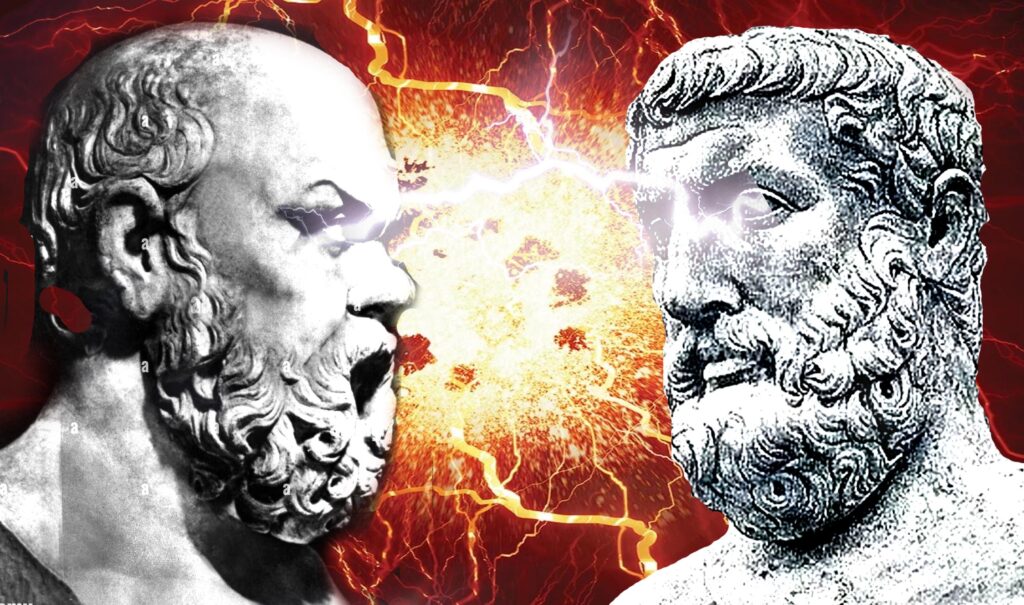When Socrates Met Parmenides

According to Plato, Socrates met the then aged and well-respected Parmenides (as well as his student Zeno) when the older philosopher was visiting Athens. It is almost impossible to imagine the actual meeting of such great historical figures, one young and the other very old, but chronologically there is every reason to believe it did happen.
Plato in his writing regards the character of the mighty Parmenides with an obvious awe, and is quite unique among the Platonic dialogues in various respects. It would seem that Zeno and Parmenides were not altogether pleased at the request of Socrates that they should venture into the nature of the one and many and the sphere of Ideas, though of course they did not retreat from the rhetorical battle. During the conversation Parmenides pokes many holes in Platonic concepts, but shows a fondness for the character of young Socrates.
‘I cannot refuse,’ said Parmenides, ‘since, as Zeno remarks, we are alone, though I may say with Ibycus, who in his old age fell in love, I, like the old racehorse, tremble at the prospect of the course which I am to run, and which I know so well. But as I must attempt this laborious game, what shall be the subject? Suppose I take my own hypothesis of the one.’
The two philosophers wasted no time getting into Parmenides’s ideas on Being (Parmenides assertion of the unity of Being). They seem to agree, in different ways, that we live in a world of appearances with only the illusion of change, while there is a higher metaphysical reality (the world of ideas) which is eternal and singular. Socrates differs from Parmenides with his idea that, while there are absolute Ideas, there are sensible things that take part in those Ideas. Parmenides believed there is nothing outside of Being, because anything else would be non-being and it is impossible to conceive of non-being. Parmenides also implies something resembling eternal unified time, as well as believing that we cannot think of something which is not real. For Socrates there is two kinds of ‘being’: that of ideas (forms) and that of sensible things. For instance physical things may take part in the perfect mathematical ‘idea’ that 1+1=2, but physical things that take part in that idea will still be destroyed by time, while the idea exists forever, as it has not phyisical existence.
But what is most remarkable about the dialogue is what ensues from the argument, which is a curious refuation of both Platonic (and Parmenidean) ideas – laying out what would become the essential points of Aristotle. As only a philosopher can do, Plato raises in this dialogue his own most severe criticisms, against the ideas he has worked so hard to develop. Why would he wish to publish that?
The truth is that the Platonic concepts were and are in a constant process of development and transmutation – like life itself. Platonic ideas often presented by him as fixed and eternal are in other passages spoken of as subjective to viewpoint. While to a novice this seems contradictory, we can see here the deepest aspect of philosophical introspection: the Heraklitian concept of the inescapability of change. Or the difficulty of establishing ideas ‘absolutely’ in the sensible world, which are best observed via socratic questioning, and best expressed as veiled in poetry and mythology,
Plato is quite serious in publishing his own objections to his doctrines, and Socrates does not offer to answer them. They are a thing to be noted, to be aware of, though they may be weaponised by the dogmatic statements of Aristotle or Nietzsche.
Philosophy requires one to turn away from the material world and look up towards the world of Ideas. Plato sees this as the soul’s movement towards God.
The two divisions of the Parmenidean argument:
1. One is.
2. One is not.
If one is, it is nothing.
If one is not, it is everything.
But is and is not may be taken in two senses:
Either one is one,
Or, one has being,
from which opposite consequences are deduced,
1.a. If one is one, it is nothing.
1.b. If one has being, it is all things.
To which are appended two subordinate consequences:
1.aa. If one has being, all other things are.
1.bb. If one is one, all other things are not.
The same distinction is then applied to the negative hypothesis:
2.a. If one is not one, it is all things.
2.b. If one has not being, it is nothing.
Involving two parallel consequences respecting the other or remainder:
2.aa. If one is not one, other things are all.
2.bb. If one has not being, other things are not.











